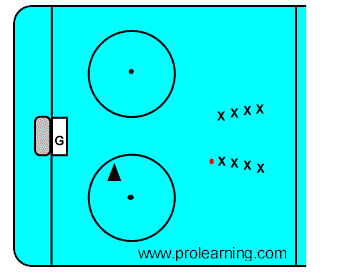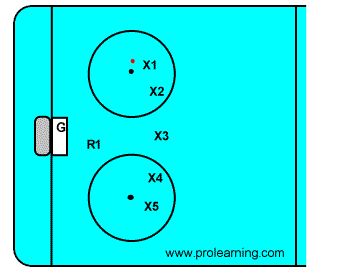
Don't Pass Up Those Rebounds
by Greg Siller
Besides scoring from a direct shot on net, rebounds are another great way to put the biscuit in the basket. You should look to improve your teams scoring opportunities by up to 25% when you become consistent at capitalizing on rebounds.
Follow The Leader
One way to pick up more goals is to get into the habit of following in on your initial shot to take advantage of any rebound that may occur. The average goaltender allows many rebounds, especially from low shots. If you follow up your shot and position yourself correctly, these rebounds can be turned into additional scoring opportunities. To get better at reacting to rebounds, you need to read the goaltenders patterns. Study the goaltender to see how the rebounds come out from his pads, stick, blocker, chest, and skates. This information is important because it gives you clues regarding where to position yourself following a shot from a particular location. If you are not in position for a shot and have no one to pass to, keep your shot low (knee level or below) so that you have the best chance to get any rebounds. Avoid the bad habit of shooting and then watching to see what happens. Become proactive with your shooting!
Timing, quickness, and strength to move into position in front of the net are essential factors in obtaining rebounds. With limited space and defensive coverage by the opponents in the slot, you must be strong on your skates, work your way to the puck, anticipate the shot from your teammate (if your teammate is the shooter), obtain the rebound, and shoot the puck. Sometimes a player can anticipate where a rebound might go, but the two keys to obtaining rebounds are to position aggressively in the scoring area (based on the trajectory of the original shot) and to focus on puck movement while keeping your stick on the playing surface. If your stick is initially tied up by an opposing defenseman, use your skates to initially control the rebound, get your stick free, and then put the puck in the net. The determination to drive the rebound home is the mark of a great scorer and should be a main feature in all rebound drills.
Two For One
Two drills that focus on rebounds are (1) following in on your own shot/a teammates shot, and (2) positioning yourself near the net while your teammates shoot.
For the first drill, position players in two lines near the center red line (see the active Figure below). At the whistle, have one shooter skate in on net with the puck. When the shooter is about 15 feet from the net (marked with a cone), have the player shoot at the goaltender (pads or stick area). After the shot, he (or she) should follow in for the rebound. Players should alternate lines so that they get practice both as a shooter and as a trailer getting the rebound. For this drill, the goaltender should make an effort to deflect rebounds out to the slot (as opposed to the corners) to help the shooters practice getting rebounds.

Repeat this drill with a teammate (the trailer) following in 5-to-10 feet behind and to the side of the initial shooter. Once the shooter takes the shot, the trailer should continue in for the rebound.
For the second drill, place 5 players (X1 - X5) in a semi-circle, about 15 to 40 feet from the net, depending on the type of shot used. Place 1 player (R1) in front of/off to the side of the net, depending on the location of the shooter (see the active Figure below). R1 will need to reposition for each shot depending upon where the shot is coming from. Have the players shoot, one at a time, and let the R1 work to get the rebounds and put the puck in the net. The initial shots from X1 - X5 should be low and at a moderate speed so that R1 can get used to the proper positioning, shot speed, and rebound direction. Rotate the players after several sets of shots so that each player gets an opportunity to shoot and to get the rebounds.

The initial shot and potential rebound provide teams with two opportunities to score. Take advantage of this one-two punch and increase your scoring potential during each practice and game!
Greg Siller, author of the book Roller Hockey: Skills and Strategies for Winning on Wheels, can be contacted at Siller@ProLearning.com or via his website at www.ProLearning.com.